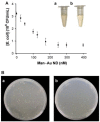Antimicrobial Gold Nanoclusters: Recent Developments and Future Perspectives
- PMID: 31208013
- PMCID: PMC6627976
- DOI: 10.3390/ijms20122924
Antimicrobial Gold Nanoclusters: Recent Developments and Future Perspectives
Abstract
Bacterial infections have caused serious threats to public health due to the antimicrobial resistance in bacteria. Recently, gold nanoclusters (AuNCs) have been extensively investigated for biomedical applications because of their superior structural and optical properties. Great efforts have demonstrated that AuNCs conjugated with various surface ligands are promising antimicrobial agents owing to their high biocompatibility, polyvalent effect, easy modification and photothermal stability. In this review, we have highlighted the recent achievements for the utilizations of AuNCs as the antimicrobial agents. We have classified the antimicrobial AuNCs by their surface ligands including small molecules (< 900 Daltons) and macromolecules (> 900 Daltons). Moreover, the antimicrobial activities and mechanisms of AuNCs have been introduced into two main categories of small molecules and macromolecules, respectively. In accordance with the advancements of antimicrobial AuNCs, we further provided conclusions of current challenges and recommendations of future perspectives of antimicrobial AuNCs for fundamental researches and clinical applications.
Keywords: antimicrobial agent; antimicrobial mechanism; gold nanoclusters; macromolecule; small molecule.
Conflict of interest statement
The authors declare no conflict of interest. The funders had no role in the design of the study; in the collection, analyses, or interpretation of data; in the writing of the manuscript, or in the decision to publish the results.
Figures










Similar articles
-
One step synthesis of positively charged gold nanoclusters as effective antimicrobial nanoagents against multidrug-resistant bacteria and biofilms.J Colloid Interface Sci. 2020 Jun 1;569:235-243. doi: 10.1016/j.jcis.2020.02.084. Epub 2020 Feb 20. J Colloid Interface Sci. 2020. PMID: 32113021
-
Lethal Interactions of Atomically Precise Gold Nanoclusters and Pseudomonas aeruginosa and Staphylococcus aureus Bacterial Cells.ACS Appl Mater Interfaces. 2022 Jul 20;14(28):32634-32645. doi: 10.1021/acsami.2c04410. Epub 2022 Jun 27. ACS Appl Mater Interfaces. 2022. PMID: 35758190
-
Biomedical Applications for Gold Nanoclusters: Recent Developments and Future Perspectives.Nanoscale Res Lett. 2018 Sep 26;13(1):302. doi: 10.1186/s11671-018-2725-9. Nanoscale Res Lett. 2018. PMID: 30259230 Free PMC article. Review.
-
Recent advances in biomedical applications of fluorescent gold nanoclusters.Adv Colloid Interface Sci. 2017 Apr;242:1-16. doi: 10.1016/j.cis.2017.02.005. Epub 2017 Feb 16. Adv Colloid Interface Sci. 2017. PMID: 28223074 Review.
-
The assembly of protein-templated gold nanoclusters for enhanced fluorescence emission and multifunctional applications.Acta Biomater. 2020 Jan 1;101:436-443. doi: 10.1016/j.actbio.2019.10.035. Epub 2019 Oct 28. Acta Biomater. 2020. PMID: 31672583
Cited by
-
Antimicrobial Resistance and Inorganic Nanoparticles.Int J Mol Sci. 2021 Nov 29;22(23):12890. doi: 10.3390/ijms222312890. Int J Mol Sci. 2021. PMID: 34884695 Free PMC article. Review.
-
Fabrication of antibacterial sponge cleaner using gold nanoclusters.IET Nanobiotechnol. 2020 Jul;14(5):412-416. doi: 10.1049/iet-nbt.2019.0356. IET Nanobiotechnol. 2020. PMID: 32691744 Free PMC article.
-
One-Pot Synthesis of Thiol-Modified Liquid Crystals Conjugated Fluorescent Gold Nanoclusters.Nanomaterials (Basel). 2020 Sep 6;10(9):1755. doi: 10.3390/nano10091755. Nanomaterials (Basel). 2020. PMID: 32899952 Free PMC article.
-
Synergistic Effects Between Metal Nanoparticles and Commercial Antimicrobial Agents: A Review.ACS Appl Nano Mater. 2022 Mar 25;5(3):3030-3064. doi: 10.1021/acsanm.1c03891. Epub 2022 Mar 4. ACS Appl Nano Mater. 2022. PMID: 36568315 Free PMC article. Review.
-
Plasmonic Gold Nanoisland Film for Bacterial Theranostics.Nanomaterials (Basel). 2021 Nov 21;11(11):3139. doi: 10.3390/nano11113139. Nanomaterials (Basel). 2021. PMID: 34835903 Free PMC article.
References
Publication types
MeSH terms
Substances
Grants and funding
LinkOut - more resources
Full Text Sources
Molecular Biology Databases

